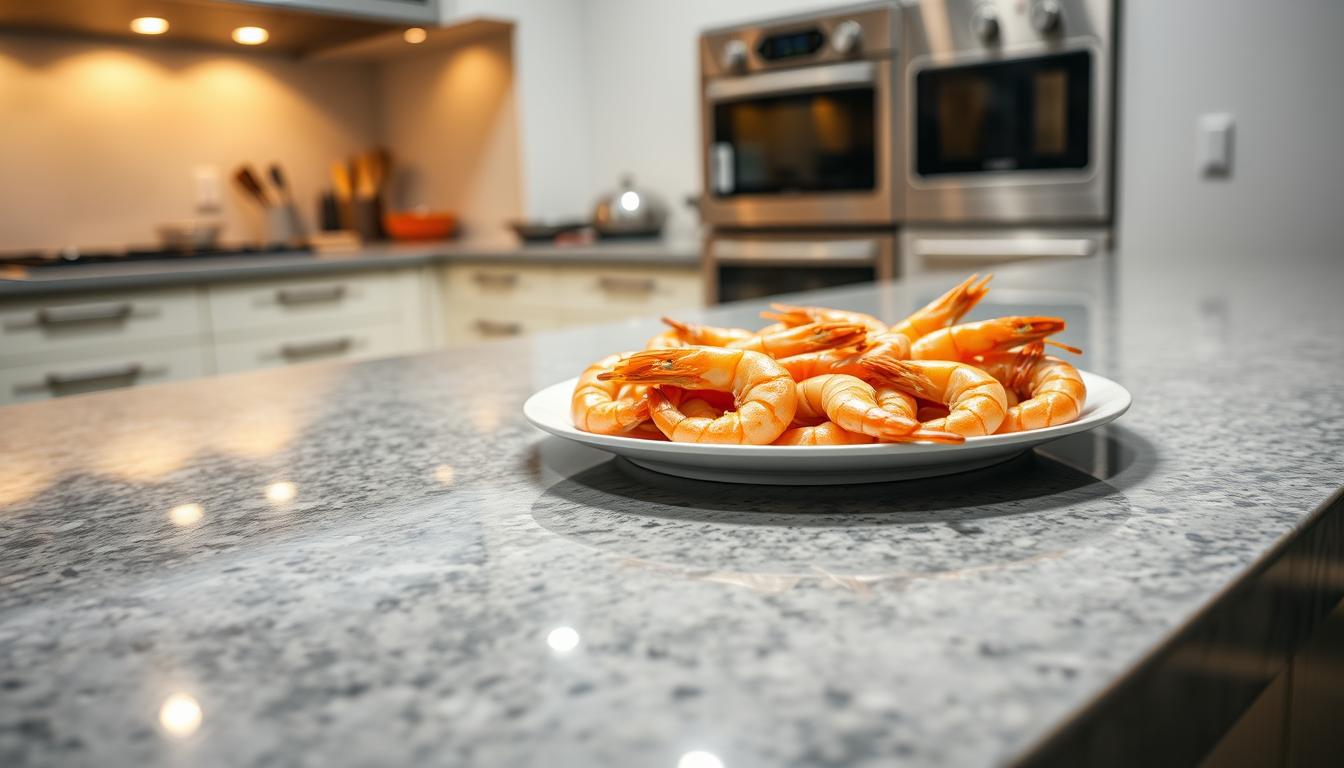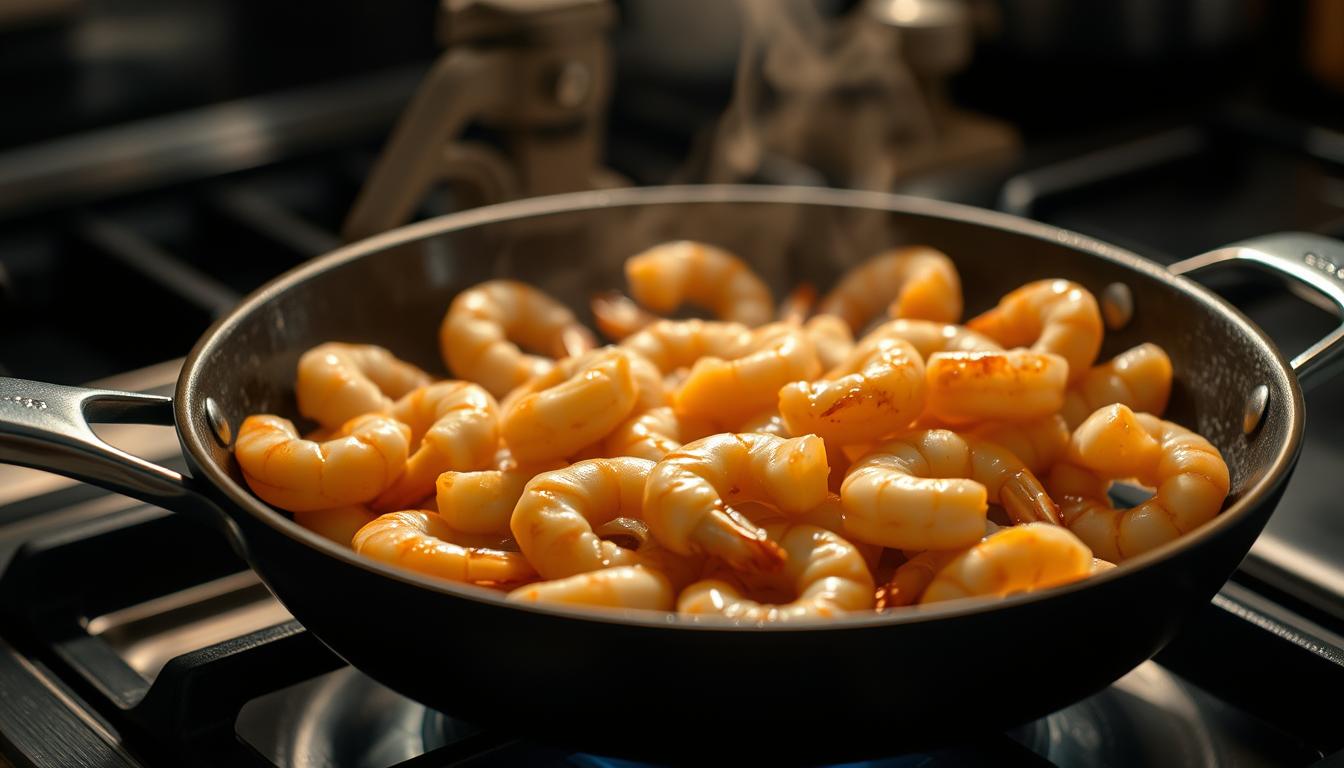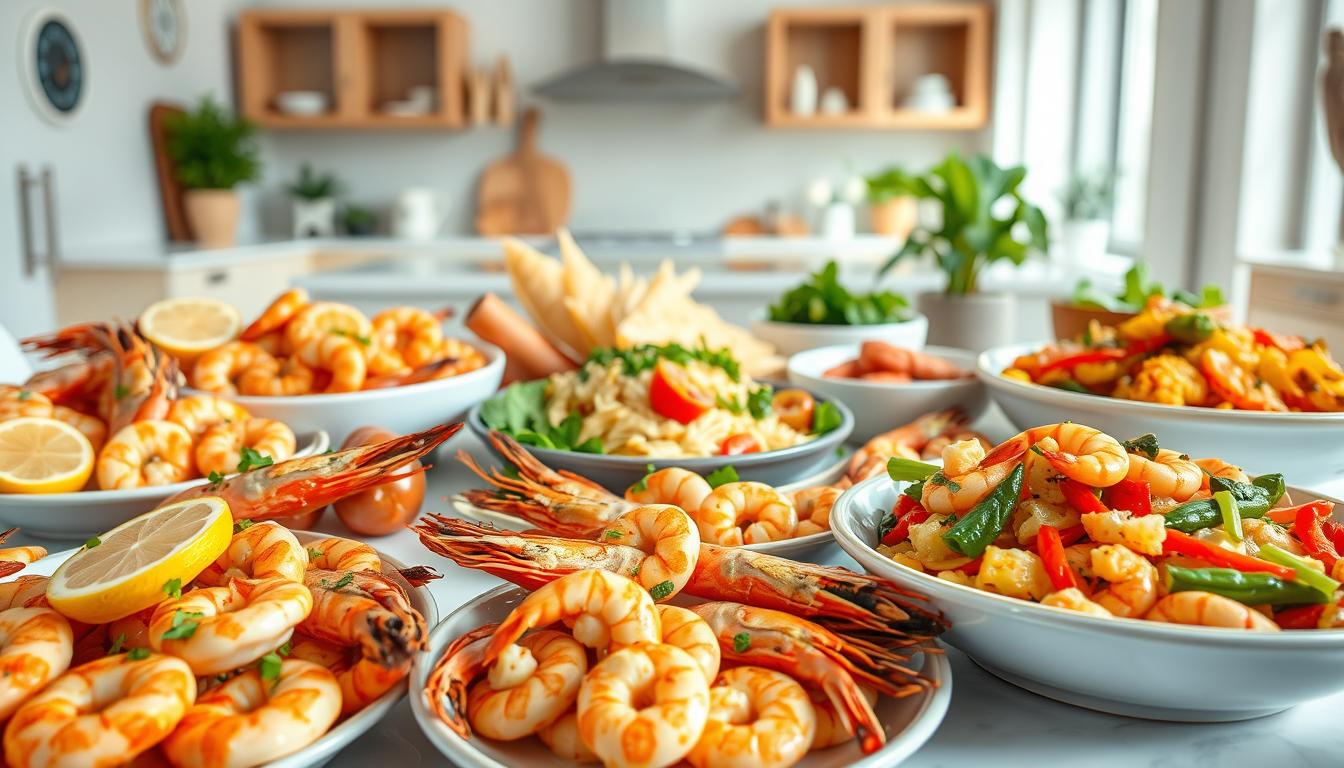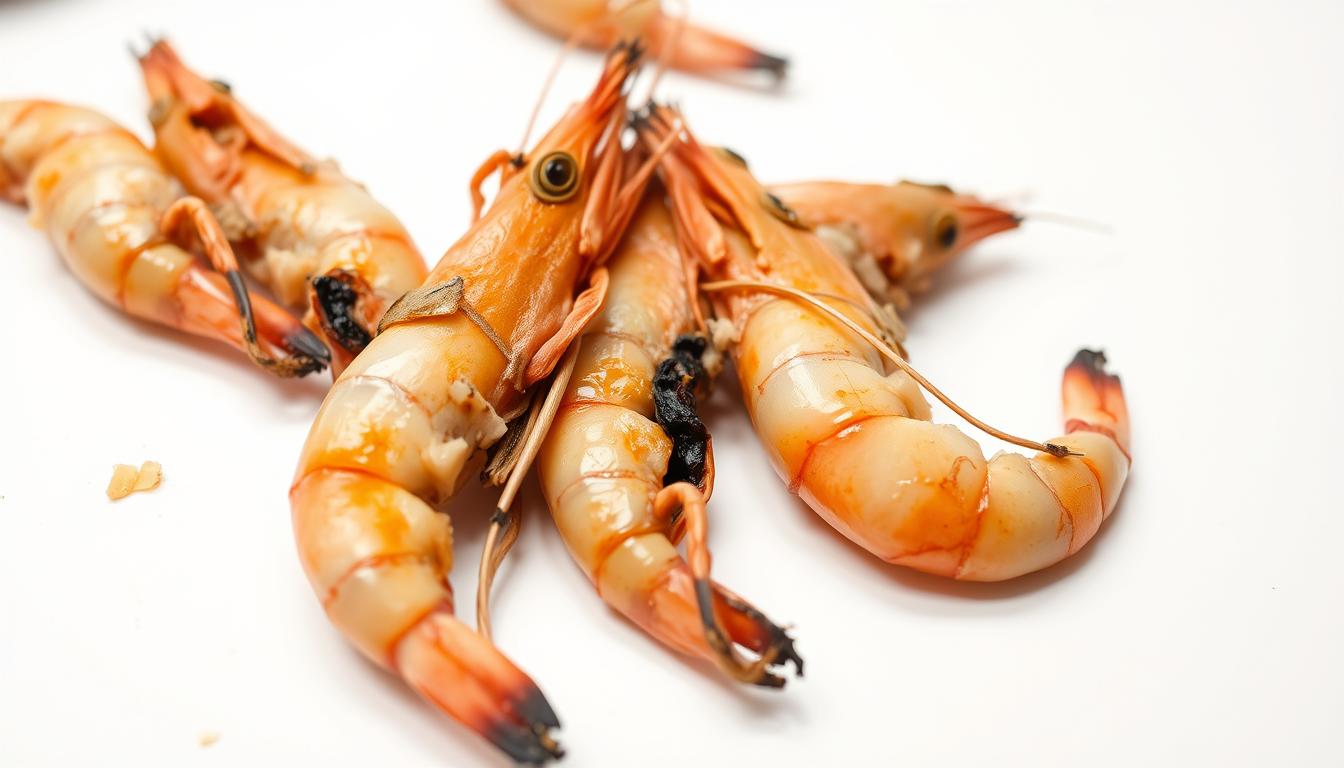Have you ever had leftover cooked prawns that you froze? Then wondered if it’s safe to reheat them?
Reheating frozen prawns can be tricky. It’s important to heat them right to avoid getting sick.

Thinking about how to reheat prawns? It’s key to know about food safety and how to do it right. This article will show you how to reheat cooked frozen prawns safely. So, you can enjoy your meal without worry.
Key Takeaways
- Safe methods for reheating cooked frozen prawns
- The importance of food safety when reheating seafood
- Tips for maintaining the quality of prawns during reheating
- Common mistakes to avoid when reheating prawns
- Best practices for storing and handling frozen prawns
Understanding Frozen Cooked Prawns
Cooking with frozen prawns is easy and healthy. They are great for many dishes. This makes them a favorite for home cooks.
What Are Cooked Frozen Prawns?
Cooked frozen prawns are prawns that have been cooked and then frozen. This keeps them fresh all year. You can find them in most supermarkets, in the frozen seafood section.
Nutritional Benefits of Prawns
Prawns are tasty and good for you. They have lots of protein and are low in fat. They also have vitamins and minerals like selenium, vitamin B12, and iodine.
Eating prawns can help your heart stay healthy. They give you important nutrients.
Common Uses for Frozen Prawns
Frozen cooked prawns are very versatile. You can use them in pasta, stir-fries, salads, and more. They are easy to reheat and add to your favorite dishes.
Learning about frozen cooked prawns can make cooking better. It helps you use this convenient ingredient well.
Safety Considerations for Seafood Reheating
To avoid foodborne illnesses, it’s crucial to understand the safety considerations for reheating seafood. Reheating seafood, especially prawns, can pose significant health risks if not handled properly. You need to be aware of the potential bacterial risks and follow guidelines to ensure safe consumption.
Bacterial Risks with Seafood
Seafood, including prawns, can be contaminated with harmful bacteria like Vibrio and Salmonella. These bacteria can cause severe food poisoning. Symptoms include diarrhea, vomiting, and abdominal cramps. When reheating seafood, it’s essential to heat it to a temperature that is high enough to kill these bacteria.
FDA Guidelines for Seafood Safety
The FDA provides guidelines for the safe handling and reheating of seafood. According to the FDA, seafood should be stored at a temperature below 40°F (4°C). It should also be reheated to an internal temperature of at least 145°F (63°C). It’s also recommended to reheat seafood within a day or two of thawing.
Safe Internal Temperature Requirements
To ensure food safety, it’s crucial to reheat prawns to a safe internal temperature. The recommended internal temperature is 145°F (63°C). Using a food thermometer can help you verify that your prawns have reached this safe temperature, reducing the risk of foodborne illness.
By following these guidelines, you can enjoy your reheated prawns while minimizing the risk of food poisoning.
Can You Reheat Cooked Frozen Prawns?
Yes, you can reheat cooked frozen prawns. But, you must do it safely and right. This way, you can enjoy your meal without worries.
The Short Answer
Yes, you can reheat cooked frozen prawns. First, thaw them well. Then, heat them to 145°F (63°C) to keep them safe.
Important Precautions
When reheating prawns, be careful:
- Thaw the prawns properly before reheating.
- Reheat the prawns to an internal temperature of at least 145°F (63°C).
- Avoid reheating prawns that have been left at room temperature for too long.
Single vs. Multiple Reheating
It’s best to reheat prawns only once. Reheating them more can lower their quality. It might also let bacteria grow.
| Reheating Frequency | Food Safety | Quality |
|---|---|---|
| Single Reheating | Safe when done properly | Maintains quality |
| Multiple Reheating | Increases risk of foodborne illness | Decreases quality |
Knowing the difference between single and multiple reheating helps. It lets you decide how to handle your prawns wisely.
Proper Thawing Methods Before Reheating
Before reheating cooked frozen prawns, thaw them right. This keeps their texture good and makes sure they’re safe to eat.
Refrigerator Thawing
Thawing in the fridge is safe. Put the prawns in a covered container or bag in the fridge. Make sure air can get to them. It takes a few hours or overnight.
Cold Water Thawing
Cold water thawing is quicker. Put the prawns in a bag and soak them in cold water. Change the water every 30 minutes. It takes about 30 minutes to an hour, depending on size.
Microwave Thawing
Microwave thawing is fast but needs care. Use the defrost setting and check the prawns often. This method is quick but can thaw unevenly if not done right.
Thawing Mistakes to Avoid
Don’t thaw prawns at room temperature or in hot water. These can cause bacteria to grow. Also, don’t thaw in the microwave without cooking or reheating right away. This can also cause bacteria to grow.
Reheating Prawns in the Microwave
Microwave reheating is a quick way to enjoy cooked frozen prawns, provided you follow the right steps.
Step-by-Step Instructions
To reheat prawns safely and effectively in the microwave, follow these steps:
- Place the prawns in a microwave-safe dish.
- Cover the dish with a microwave-safe lid or plastic wrap to retain moisture.
- Heat on a medium power setting (around 50-60% of the microwave’s power).
- Heat for short intervals (20-30 seconds) and check the prawns until they’re heated through.
Pros and Cons
Reheating prawns in the microwave has its advantages and disadvantages.
| Method | Pros | Cons |
|---|---|---|
| Microwave Reheating | Quick, Convenient | Risk of rubbery texture, Uneven heating |
Tips for Preventing Rubbery Texture
To avoid a rubbery texture when reheating prawns, consider the following tips:
- Use a lower power setting to heat the prawns more gently.
- Cover the prawns to retain moisture.
- Heat in short intervals and check frequently.
Power Settings and Timing
Adjusting the power setting and timing is crucial for successful microwave reheating. Use a medium to low power setting and check the prawns every 20-30 seconds.
Using Moisture Protection
Covering the prawns with a microwave-safe lid or plastic wrap helps retain moisture and promotes even heating.
Stovetop Methods for Reheating Prawns
The stovetop is great for reheating prawns. You can pick from many ways to get the best taste.
Sautéing Method
Sautéing is fast and good for reheating prawns. Heat a pan with a bit of oil or butter. Add the prawns and cook until they’re hot.
You can also add garlic and onions for more taste.
Steaming Method
Steaming is another good way to reheat prawns. Put the prawns in a steamer basket over boiling water. Cover and steam for a few minutes.
This keeps the prawns moist and tasty.
Adding Flavor While Reheating
Reheating prawns on the stovetop is a chance to add more flavor. You can use herbs, spices, and sauces.
Herb and Spice Recommendations
- Fresh parsley and dill add a bright, fresh flavor.
- Paprika and cayenne pepper provide a spicy kick.
- Garlic powder and onion powder enhance savory flavors.
Sauce Pairings
Try different sauces with your reheated prawns for more flavor. Some good choices are:
- Cocktail sauce for a tangy taste
- Garlic butter for richness
- Lemon butter for a citrusy flavor

Using these stovetop methods and flavor tips, you can make reheated prawns taste like they’re just cooked.
Oven and Air Fryer Reheating Techniques
Reheating cooked frozen prawns works well with the oven or air fryer. Each method keeps the prawns’ texture and taste good. But, they do it in different ways.
Oven Reheating Instructions
First, heat your oven to 275°F (135°C). Put the prawns on a baking sheet with parchment paper. Make sure they have space.
Drizzle some olive oil or butter to keep them moist. Then, cover with foil. Heat for 8-10 minutes until they’re warm.
Air Fryer Method
The air fryer is quicker. Set it to 275°F (135°C). Put the prawns in a single layer in the basket.
Cook for 3-5 minutes, shaking halfway. This method keeps the prawns tender and a bit crispy.
Temperature and Timing Guidelines
Don’t overcook the prawns. Heat them to 145°F (63°C) no matter the method. The time needed depends on the prawns’ size and how you like them.
Comparing Reheating Methods
| Method | Texture Outcome | Flavor Outcome |
|---|---|---|
| Oven Reheating | Tender, potentially dry if overcooked | Preserves natural flavor, can be enhanced with seasonings |
| Air Fryer Reheating | Can achieve a crispy exterior, tender interior | Retains flavor, can develop a roasted taste |
The oven is good for big batches and keeps moisture. The air fryer makes prawns crispy. Pick what you like best.
Incorporating Reheated Prawns Into Meals
Reheated prawns are perfect for many meals. They can make simple dishes better and add flavor to big feasts. You can use them in many cuisines, making them great for any meal.
Pasta and Rice Dishes
Prawns are great in pasta and rice dishes. Try them with linguine, garlic, and herbs for Prawn Scampi Pasta. Or mix them into Seafood Fried Rice with veggies and seasonings.
Prawn Scampi Pasta
To make Prawn Scampi Pasta, sauté prawns with garlic, lemon, and parsley. Then serve over linguine. It’s quick, tasty, and ready fast.
Seafood Fried Rice
For Seafood Fried Rice, mix prawns with cooked rice, eggs, and veggies. Add soy sauce and serve as a main or side dish.
Salads and Cold Dishes
Reheated prawns are good in cold dishes too. Chill them and add to salads with greens, tomatoes, and tangy dressing. They’re also great in cold prawn cocktails or on top of cold soups.
Soups and Hot Dishes
Reheated prawns are great in soups and hot dishes. Add them to prawn bisque or seafood chowder. Or use them in prawn stir-fries or on baked potatoes.
Quick Prawn Tacos and Wraps
For a fast meal, use prawns in tacos or wraps. Fill them with prawns, avocado, salsa, and slaw. It’s a tasty and easy option.

Proper Storage of Leftover Reheated Prawns
Storing leftover reheated prawns right is key to avoid sickness and keep them fresh. After warming them up, it’s important to handle them well to keep their quality.
Refrigeration Guidelines
Cool the prawns down to room temperature in two hours. Use shallow, airtight containers to stop bacteria from growing. This is very important inpreventing bacterial contamination.
Freezing Already Reheated Prawns
To freeze reheated prawns, cool them down first. Then put them in airtight, freezer-safe containers or bags. Try to get as much air out as you can. This keeps the prawns good for a longer time.
Storage Containers and Methods
Choose containers that are airtight and won’t leak. Glass or plastic containers with tight lids are best. For freezing, use freezer bags or vacuum-sealed containers to avoid freezer burn.
Maximum Storage Times
Reheated prawns can stay in the fridge for up to 3 days. If frozen, they can last 3 to 4 months. Always write the date on the container so you know when to use them.
By following these tips, you can safely enjoy your reheated prawns.
Signs of Spoiled Prawns to Watch For
It’s very important to check if prawns are spoiled. This keeps food safe and stops sickness. When you heat up frozen prawns, make sure they are fresh.
Visual Indicators
First, look for signs that prawns are spoiled. Fresh prawns are firm and shiny. Spoiled ones might look different.
- Discoloration: Prawns that have turned gray, black, or have an unusual color
- Slime or mold: Visible slime or mold on the surface of the prawns
- Dull appearance: Prawns that appear dull or lackluster

Smell and Texture Changes
Changes in smell and feel also show if prawns are bad. Fresh ones smell mild or nothing. Bad ones smell bad. They might feel soft or sticky.
- Soft or mushy texture: Prawns that feel soft or mushy to the touch
- Sticky or slimy texture: Prawns with a sticky or slimy surface
When to Discard Prawns
If you see any bad signs, throw the prawns away. Eating bad prawns can make you very sick. It’s safer to be careful.
Food Safety and Illness Prevention
To avoid getting sick, handle, store, and cook prawns right. Here are some tips:
| Practice | Description | Benefit |
|---|---|---|
| Proper Storage | Store prawns in sealed containers at the right fridge temperature. | Stops bad bacteria from growing. |
| Cooking to Safe Temperature | Heat prawns to the right internal temperature. | Kills harmful bacteria. |
| Regular Inspection | Check prawns often for spoilage before eating. | Finds and removes bad prawns, preventing sickness. |
Conclusion
Now you know how to safely reheat frozen prawns. You can add them to your meals with confidence. This is true whether you want to bring out the flavor or try new recipes.
Thaw and reheat your prawns right to enjoy a tasty and healthy meal. They’re great in pasta, rice, salads, and tacos. So, reheat your prawns and start cooking something new!
FAQ
Can you reheat cooked frozen prawns?
Yes, you can reheat cooked frozen prawns. But, it’s key to do it safely to avoid getting sick.
What is the best way to reheat frozen prawns?
The best way to reheat frozen prawns depends on what you like. You can use the microwave, stovetop, oven, or air fryer.
How do you prevent rubbery texture when reheating prawns?
To avoid a rubbery texture, don’t overcook them. Use a gentle heat. Adding lemon juice or butter can also help.
Can you reheat prawns multiple times?
It’s not good to reheat prawns many times. This can make you sick. Try to reheat them only once.
How do you store leftover reheated prawns?
Cool leftover prawns down fast, then refrigerate or freeze them. Use airtight containers and follow safe storage tips.
What are the signs of spoiled prawns?
Spoiled prawns might look slimy, be off color, or smell bad. If you see these signs, throw them away to stay safe.
Can you freeze already reheated prawns?
Freezing reheated prawns is not a good idea. It can make them unsafe and less tasty.
How do you add flavor when reheating prawns?
To add flavor, try herbs, spices, and sauces. Garlic, lemon juice, and chili flakes are great. Mix them to find your favorite.
